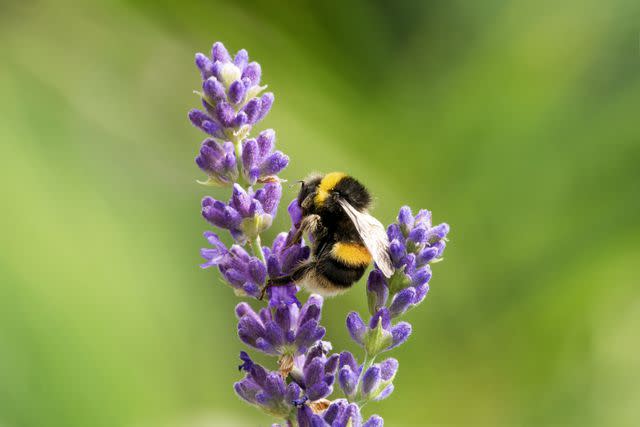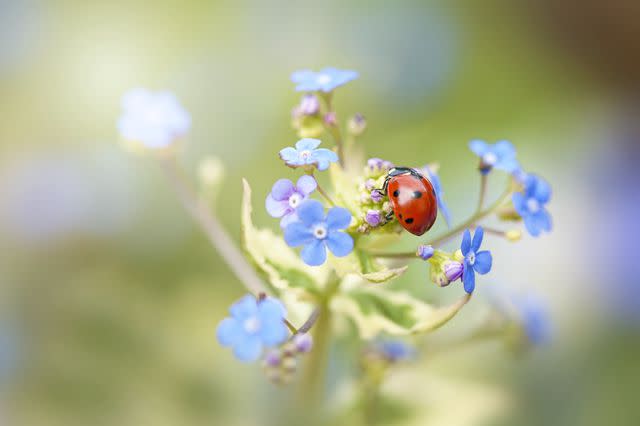7 Ways to Attract Beneficial Bugs to Your Yard—and Why You Should
Beneficial insects act as natural pest control, improve the health of your plants, and more.
While bugs are commonly perceived as a negative thing in the garden, many insects are actually very beneficial and will act as natural pest control. Rather than finding ways to keep bad bugs away from your plants, consider how to support and increase the many good bugs in your landscape. Enticing beneficial insects to your garden will reduce dependence on chemical pesticides, increase pollination, improve soil quality, and produce healthier plants. Ahead, we spoke to experts about the insects that do good and how to attract them to your garden.
Related: 15 Pollinator Plants That Will Attract Birds, Bees, and Butterflies to Your Garden
Benefits of Good Bugs
There are many reasons to welcome beneficial bugs to your yard and garden.

Busybee-CR / Getty Images
Provide Natural Pest Control
Insects play a crucial role in the ecosystem and in the garden. Good bugs eat less desirable insects that can harm your plants, acting as a natural pest control. "Attracting beneficial insects to your garden such as predators and parasitoids—natural enemies—will provide biocontrol services on your desirable plants," says Adam Baker, technical advisor for the Davey Institute.
Improve the Health of Your Plants
Many beneficial bugs increase the health of your plants by encouraging seed set and keeping pest populations in check, says Leah Brook, public programs coordinator at Mt. Cuba Center. By keeping harmful insects at bay, beneficial bugs also protect your plants from damage and disease.
Increase Pollination
When you plant a garden with the ecosystem in mind, you'll attract pollinators and beneficial insects that feed on nectar and pollen. "Attracting more pollinators to your landscape may increase ecosystem function by facilitating the formation of seeds and fruits that provide energy in food-webs," says Baker.
Support Ecosystems
A garden full of beneficial insects not only reduces pests, it provides habitat and food sources for other wildlife, supporting the ecosystem at large. "Attracting insects using host plants, such as native caterpillars, will provide food for higher trophic levels such as other insects, birds, amphibians, and reptiles," says Baker.
Related: How to Prevent and Get Rid of Mealybugs, a Common Pest That Can Harm Almost Any Houseplant
Beneficial Bugs
These beneficial insects can help with pest control, soil aeration, and more.
Ants
Ants may be a nuisance when they enter your home, but they can be beneficial in the garden. These tiny insects are hard workers that tunnel in the soil to improve aeration. Aerated soil promotes healthy root growth, says Baker.
Beetles
Beetles are important decomposers that help break down organic material in the soil. Increase their presence by providing hiding spots for beetles and their prey with patches of tall grasses, leaf litter, wood piles, loose stones, or compost, says Baker. Plant a beetle bank—a strip or area of perennial native grass—and place it in safe areas near pollen.
Bees
Bees are important pollinators that feed on the nectar and pollen of flowers. Honey bees, for example, are responsible for pollinating over 130 fruits and vegetables. These beneficial insects typically look for fragrant flowers that are open during the daytime and are often tubular.
Ladybugs
Ladybugs eat smaller soft-bodied pests, including mites, scale, and some insect eggs. "One ladybug can consume hundreds of aphids a day and thousands in its lifetime," says Baker. To attract more ladybugs to your landscape, plant flat-topped flowers, such as yarrow.
Lacewings
Small insects with green or brown bodies and transparent wings, lacewings may look delicate but they are a welcome delight in the garden. These beneficial insects consume many garden pests, including aphids.
Parasitoid wasps
Parasitoid wasps lay their eggs inside other insects to continue their lifecycle. For example, the tomato hornworm that eats tomato plants is an insect parasitoid wasps use to reproduce. "These wasps can control tomato hornworms by laying their eggs inside the insect," says DiFilippo. "These eggs then hatch out of and feed on the hornworm, in turn protecting your tomato plants from damage."
Praying mantises
Praying mantises camouflage with their environment making it easier for them to hunt and feast on their prey. A welcome insect in the garden, these creatures are wonderful at eating plenty of unwanted insects that may appear in your garden. Praying mantises are fierce predators that will control grasshoppers, flies, and cabbage moths in the garden, says Baker,

Jacky Parker Photography / Getty Images
How to Attract Beneficial Bugs to Your Yard
There are many ways to attract beneficial insects to your yard, but these are some of the most tried-and-true methods.
Try Companion Planting
Companion planting is the practice of choosing plants that thrive when grown together. This style of gardening provides many benefits, such as reducing weeds and adding nutrients to the soil. "Companion planting is a great way to deter or attract certain insects to your garden," says Olivia DiFilippo, horticulture manager at the Delaware Center for Horticulture. For example, plants like tomatoes and peppers have small flowers that are often hidden in the leaves—adding brightly colored flowers nearby will attract pollinators.
Related: Use Our Companion Planting Chart to Grow a Thriving Vegetable Garden
Avoid Chemical Pest Control
The issue with chemical pest control, whether it's a pesticide, insecticide, or herbicide, is you're killing everything where you spray. "People should reconsider their pesticide use in the garden because the non-specific, broad-spectrum sprays that are often used to eliminate pest insect problems also harm beneficial insects," says Brook. "When you spray for mosquitoes, you are spraying your caterpillars, ladybugs, bees."
Pesticides also contaminate soil and waterways. "Pesticides (especially herbicides) can leach into the ground, contaminating our rivers and waterways," says DiFilippo. Before reaching for a chemical solution, consider natural methods for reducing pests.
Related: How to Rid Your Garden of 5 Common Summertime Pests
Add a Water Feature
All living beings need water, and insects are no exception. Consider adding a water feature so beneficial insects have access to water. "Water features and puddlers are a vital source of hydration for butterflies, dragonflies, and other beneficial insects, especially during hot and dry periods," says Mary Phillips, head of native plant habitat strategy and certifications at the National Wildlife Federation.
A water feature can be as simple as setting out a bowl or garden saucer. "Create a shallow area at the edge of your water feature, or add some smooth rocks," says Phillips. "Include a few small twigs or sticks in the water feature to create perching spots for insects."
Related: How to Create a Water Garden, a Soothing Backyard Feature for Aquatic Plants and Fish
Grow Long-Blooming Plants
Beneficial insects and pollinators need nectar and food sources year-round, which you can provide by growing plants with long-bloom times. "It’s important to plant a diverse array of native flowers with varying bloom times to attract and sustain populations of beneficial insects all through the season," says Brook. Some examples of long-blooming plants include anise hyssop, blanket flower, and aster.
Grow Larval Host Plants
Larval host plants, like violets, milkweed, and asters, provide essential nutrients that caterpillars need to grow and develop properly before transforming into butterflies. "By planting host plants, gardeners provide a healthy environment that will ensure the next generation of butterflies and pollination for thriving plants," says Phillips. As the caterpillars grow and munch on leaves, they also provide a nutrient-rich food source for birds.
Related: 15 Pollinator Plants That Will Attract Birds, Bees, and Butterflies to Your Garden
Leave Yard Debris
When one garden season ends, you may be tempted to tidy up an area by removing dead stems, stumps, branches, and leaves. Beneficial insects rely on this material for habitat. Many insects also overwinter and use these types of shelters to protect themselves from harsh winter conditions. Branches and trunks are also a food source for many beneficial bugs. "The slow decomposition of stumps and branches provides a continuous source of food for detritivores that break down dead organic matter," says Phillips.
Grow Native Plants
Native plants—species that are naturally found in your specific region—are essential for insects, wildlife, and the ecosystem. "Native insects and native plants have evolved together over time, and many of these insects are adapted to the specific features of native plants, from leaf shapes to flower structures, scent, and color," says Phillips.
Related: Looking for Some Backyard Inspiration? Consider Starting a Native Plant Garden
Read the original article on Martha Stewart.

